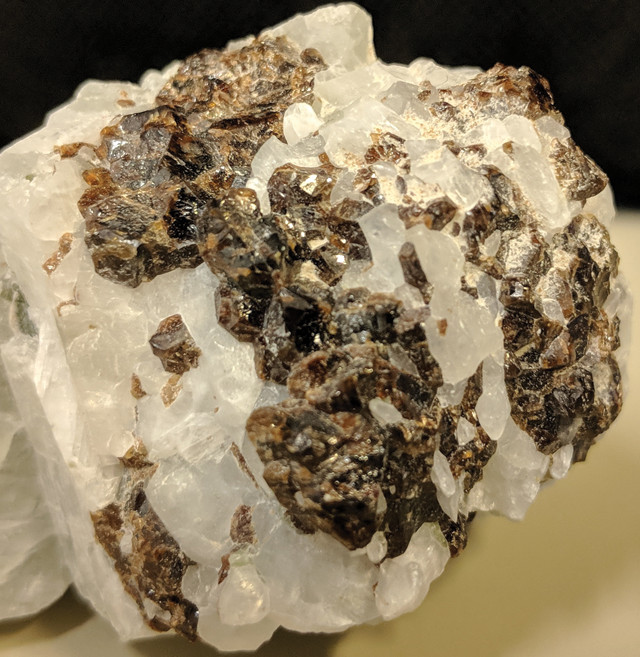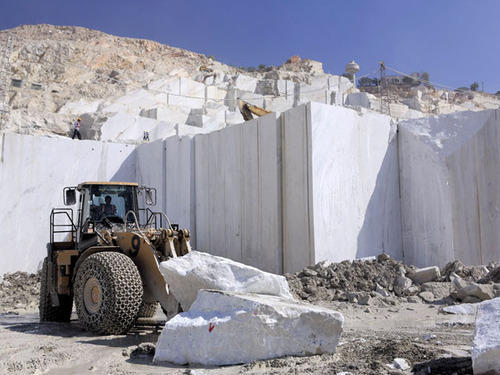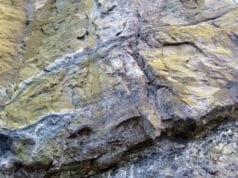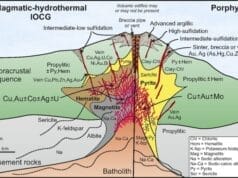Metamorphic ore minerals are minerals that form during the process of metamorphism, which is the alteration of pre-existing rocks due to changes in temperature, pressure, and/or fluid composition. Metamorphic ore minerals can form in a wide range of rock types, including sedimentary, igneous, and other metamorphic rocks. Some examples of metamorphic ore minerals include:

- Garnet: Garnet is a common metamorphic mineral that can form under a wide range of conditions. It is often found in metamorphic rocks such as schists and gneisses, and can contain valuable ore minerals such as gold, silver, and copper as inclusions or replacements.
- Staurolite: Staurolite is a metamorphic mineral that forms in medium to high-grade metamorphic rocks, such as schists and gneisses. It often contains inclusions of other minerals, including ore minerals such as graphite, sulfides, and magnetite.
- Kyanite: Kyanite is a high-pressure metamorphic mineral that forms in the metamorphism of clay-rich sediments and pelitic rocks. It can contain inclusions of valuable ore minerals such as corundum and rutile.
- Sillimanite: Sillimanite is a metamorphic mineral that forms at high temperatures and pressures, typically in regional metamorphic settings. It can contain inclusions of valuable ore minerals such as corundum, tourmaline, and garnet.
- Graphite: Graphite is a metamorphic mineral that forms in the metamorphism of organic-rich sedimentary rocks such as coal and shale. It is an important source of graphite, which is used in a wide range of applications including pencils, lubricants, and batteries.
- Talc: Talc is a metamorphic mineral that forms in the metamorphism of magnesium-rich rocks such as serpentinite and dolomite. It is an important source of talc, which is used in various industrial applications, including ceramics, paint, and cosmetics.
- Marble: Marble is a metamorphic rock that forms from the metamorphism of limestone or dolomite. Marble can contain valuable ore minerals such as magnesite, which is used in the production of magnesium metal.
These are just a few examples of metamorphic ore minerals. The specific characteristics, formation processes, and economic significance of metamorphic ore minerals can vary widely depending on the specific minerals involved, the metamorphic conditions, and the geological context.
Formation of ore minerals during metamorphism
Ore minerals can form during metamorphism through various processes, depending on the specific conditions and mineral assemblages involved. Some common mechanisms of ore mineral formation during metamorphism include:
- Metamorphic differentiation: During metamorphism, minerals can undergo differentiation, where certain elements or ions become concentrated in specific minerals, leading to the formation of ore minerals. For example, in the metamorphism of sedimentary rocks rich in iron and manganese, the minerals hematite and pyrolusite can form as the iron and manganese become concentrated during metamorphism.
- Metasomatism: Metasomatism is the process of chemical exchange between rocks and fluids during metamorphism. Fluids, such as hydrothermal fluids or metamorphic fluids derived from the rock itself, can infiltrate and interact with the minerals in the rock, leading to the formation of new minerals, including ore minerals. For example, during regional metamorphism, fluids rich in metal ions can infiltrate the rock, leading to the formation of ore minerals such as sulfides, oxides, and carbonates.
- Recrystallization and re-equilibration: During metamorphism, minerals in the rock can undergo recrystallization and re-equilibration, where they dissolve and re-precipitate in new mineral forms that are stable under the new metamorphic conditions. This can lead to the formation of new minerals, including ore minerals. For example, in the metamorphism of shale, the minerals chlorite and biotite can recrystallize and re-equilibrate to form micas such as muscovite or phengite, which may contain valuable ore minerals such as molybdenite or tungsten minerals.
- Fluid-rock reactions: Fluid-rock reactions occur when fluids interact with the minerals in the rock, leading to the exchange of elements and the formation of new minerals, including ore minerals. For example, in the metamorphism of basaltic rocks, the interaction of hydrothermal fluids with the minerals in the rock can lead to the formation of ore minerals such as sulfides, oxides, and silicates.
The formation of ore minerals during metamorphism is a complex process that depends on the specific conditions, mineral assemblages, and fluid compositions involved. It can result in the formation of various types of ore deposits, including metamorphic-hosted ore deposits, skarn deposits, and others. The economic significance of metamorphic ore deposits depends on the type of ore minerals formed, their abundance, and their concentration, which can vary widely depending on the specific geological setting.

Types of metamorphic ore deposits
Metamorphic ore deposits are formed during the process of metamorphism, which involves the transformation of pre-existing rocks into new rock types through changes in temperature, pressure, and mineralogical composition. Metamorphic ore deposits can be classified into various types based on their geological characteristics, mineralogy, and economic significance. Some common types of metamorphic ore deposits include:
- Skarn deposits: Skarns are metamorphic rocks that form at the contact zone between an intrusive igneous rock and a carbonate-rich host rock, such as limestone or dolomite. Skarn deposits can contain a wide range of ore minerals, including iron, copper, zinc, tungsten, molybdenum, and others. Skarn deposits are often associated with contact metamorphism and can be economically significant due to the high concentrations of ore minerals found in them.
- Metamorphic-hosted ore deposits: These are ore deposits that are formed directly within metamorphic rocks, without any associated igneous intrusion or hydrothermal fluids. Examples include metamorphic-hosted gold deposits, metamorphic-hosted graphite deposits, and metamorphic-hosted manganese deposits. These deposits can form through a variety of metamorphic processes, such as metamorphic differentiation, metasomatism, and fluid-rock reactions.
- Metamorphic-exhalative deposits: These deposits form from the deposition of ore minerals from hydrothermal fluids that are exhaled from the rock during metamorphism. These fluids can deposit ore minerals in fractures, faults, and other openings in the rock, leading to the formation of ore deposits. Examples of metamorphic-exhalative deposits include lead-zinc deposits, copper deposits, and silver deposits.
- Metamorphic-metasomatic deposits: These are ore deposits that form through the exchange of elements between the rock and fluids during metamorphism. Metamorphic-metasomatic deposits can form in a variety of rock types and can contain a wide range of ore minerals, including iron, copper, zinc, tungsten, molybdenum, and others.
- Marble-hosted ore deposits: Marble is a common metamorphic rock that forms from the recrystallization of limestone or dolomite. Marble-hosted ore deposits can form when the marble contains high concentrations of certain elements, such as magnesium, lead, zinc, or copper, which can be economically extracted as ore minerals.
These are just a few examples of the different types of metamorphic ore deposits. The classification of metamorphic ore deposits can be complex and is often based on a combination of geological characteristics, mineralogy, and economic significance. The formation of metamorphic ore deposits is influenced by a variety of factors, including the composition of the original rock, the temperature and pressure conditions during metamorphism, the availability of fluids, and the presence of ore-forming elements, among others.

Examples of metamorphic ore deposits
There are several examples of metamorphic ore deposits, which include:
- Skarn deposits: Skarns are metamorphic rocks that form at the contact zone between an intrusive igneous rock and a carbonate-rich host rock, such as limestone or dolomite. Skarn deposits can contain a wide range of ore minerals, including iron, copper, zinc, tungsten, molybdenum, and others. Examples of skarn deposits include the Bingham Canyon copper-gold deposit in Utah, USA, and the Kara mine in Sweden, which is known for its iron, copper, and gold mineralization.
- Greenstone-hosted gold deposits: Greenstone belts are metamorphic rock sequences that are commonly associated with gold mineralization. These belts can contain gold-bearing quartz veins or disseminated gold within the host rock. Examples of greenstone-hosted gold deposits include the Witwatersrand Basin in South Africa, which is one of the world’s largest gold deposits and has been a significant source of gold production for over a century.
- Graphite deposits: Graphite is a metamorphic mineral that can form in high-grade metamorphic rocks, such as gneiss and schist, through the metamorphism of carbon-rich sedimentary rocks, such as coal or organic-rich shales. Examples of graphite deposits include the deposits in the Jixi area in China, which is one of the largest graphite producing regions in the world.
- Garnet deposits: Garnet is a metamorphic mineral that can form in a variety of rock types, including schist, gneiss, and amphibolite. Garnet deposits can be economically valuable due to their industrial applications as abrasive materials. Examples of garnet deposits include the Barton garnet mine in New York, USA, and the Alder Creek deposit in California, USA.
- Marble-hosted lead-zinc deposits: Lead-zinc deposits can also form in metamorphic rocks, particularly in marbles that have been enriched in lead and zinc through fluid-rock interaction during metamorphism. Examples of marble-hosted lead-zinc deposits include the Pine Point deposit in Canada, which was a significant lead-zinc producer in the past.
- Metamorphic-metasomatic iron ore deposits: Iron ore deposits can also form in metamorphic rocks through metasomatism, which involves the exchange of elements between fluids and rocks during metamorphism. Examples of metamorphic-metasomatic iron ore deposits include the Kiruna iron ore deposit in Sweden, which is one of the largest and most famous iron ore deposits in the world.
These are just a few examples of the wide variety of metamorphic ore deposits that exist globally. The specific type and composition of ore minerals in metamorphic deposits can vary greatly depending on the local geology, metamorphic conditions, and mineralizing processes that occurred during the formation of the deposit.




































